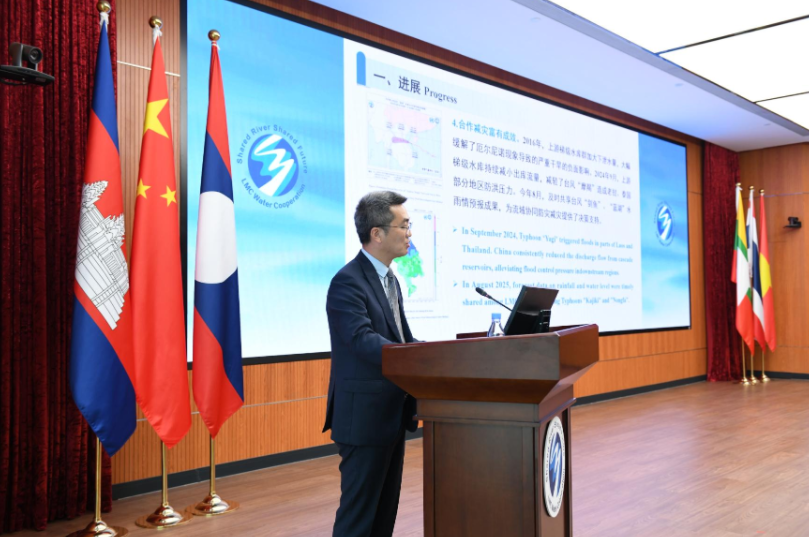As the Lancang-Mekong water resources cooperation approaches its 10th anniversary, consensus among the six riparian countries has deepened and tangible results have been achieved in information sharing, joint disaster reduction, livelihood projects, and exchanges in technology and personnel.

Zhou Zhiwei, secretary general of the Lancang-Mekong Water Resources Cooperation Center, delivers a keynote speech at the fourth Lancang-Mekong Water Resources Cooperation Forum held in Wuhan, Hubei province, Sept. 24, 2025. [Photo provided to China.org.cn]
"Since the official establishment of the Lancang-Mekong water resources cooperation mechanism in 2017, it has become the first water resources cooperation platform covering all six countries in the basin," said Zhou Zhiwei, secretary general of the Lancang-Mekong Water Resources Cooperation Center, at the fourth Lancang-Mekong Water Resources Cooperation Forum held in Wuhan, Hubei province, from Sept. 24 to 25.
He noted that nearly 30 high-level meetings—including ministerial meetings, joint working group sessions, and special forums—have been convened in recent years, producing key documents such as the Five-Year Plan of Action on Lancang-Mekong Water Resources Cooperation (2023-2027) and the Initiative on Deepening Lancang-Mekong Water Resources Cooperation. These, he said, have consolidated consensus and provided a roadmap for advancing orderly cooperation.
According to Zhou, through the Lancang-Mekong Water Resources Cooperation Information Sharing Platform, China has so far released nearly 100,000 pieces of hydrological data. In August, it promptly shared forecasts on Typhoons Kajiki and Nongfa, offering crucial decision support for coordinated disaster prevention in the basin. On this basis, the joint working group reached consensus on a memorandum of understanding to facilitate mutual provision of hydrological data between upstream and downstream countries.
Zhou also highlighted the Lancang-Mekong Sweet Spring project, under which China has funded and technically supported the construction of 93 rural water supply sites in Cambodia, Laos, and Myanmar. The initiative, providing "low-cost and high-quality" water supply services, has benefited more than 12,000 people across seven provinces and 27 villages.
On technology and personnel exchanges, Zhou said experts from the six member countries have conducted over 10 joint studies on climate change, river hydrology, and ecological systems in the Lancang headwaters, Tonle Sap Lake, and the Mekong Delta. Annual activities such as "Lancang-Mekong Week" and "Lancang-Mekong Trip" have also helped strengthen people-to-people ties.
Despite the basin's strong water resource endowment, Zhou underlined two major challenges: the growing frequency of extreme hydrological events such as droughts and floods, and insufficient coordination in water management due to differing development levels among member states.
Looking ahead, he proposed that the six countries place greater emphasis on water conservation, harmony between humans and water, systematic approaches, and intelligent technologies, while ensuring full implementation of the five-year action plan. He called for closer policy coordination on water governance to build a "Lancang-Mekong Cooperation 2.0" characterized by unity and cooperation, openness and win-win outcomes, green innovation, and peace and tranquility.
The forum concluded with the release of the Wuhan Initiative of the fourth Lancang-Mekong Water Resources Cooperation Forum, which establishes an open platform for policy dialogue and technical exchange.


 Share:
Share: 




 京公网安备 11010802027341号
京公网安备 11010802027341号